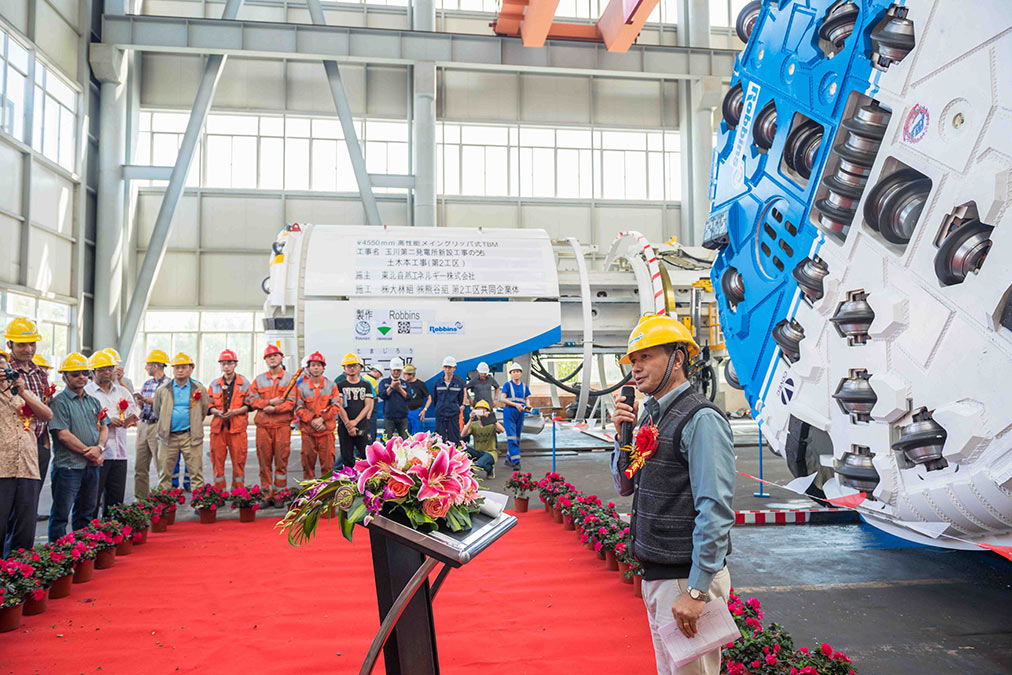Nepal will welcome its first ever TBM this Summer when a 5.06m diameter double shield Robbins machine will arrive in the mountain kingdom to excavate a 12.2km long tunnel for the Bheri Babai multi-purpose irrigation, water supply and hydropower project. The TBM underwent its factory acceptance testing in July and is currently being shipped to the jobsite in the Siwalik Range, part of the Southern Himalayan Mountains. Pre-construction works for the project, including laying gravel onto rural roads and excavating wells for drinking water, has been completed to make way for transportation of the TBM to site and its launch and operation in the remote location.
The Bheri Babai project is one of 11 National Pride Projects sanctioned by the Government of Nepal to further develop the mainly rural country. This project will irrigate 60,000 hectares (almost 15,000 acres) of land in the southern region of Nepal, benefitting an estimated 30,000 households. It will divert 40m3/sec of water through the tunnel from the Bheri River to the Babai River (Fig 1) using the head of 150m to operate a 48 MW turbine and produce hydropower to benefit the country by about US$20 million annually. A new 15m tall dam will create a reservoir to provide year-round irrigation in the surrounding Banke and Bardia districts.
The Nepal branch of the China Overseas Engineering Group (COVEC) and represented by the Chengtong branch the China Railway No 2 Engineering Co is responsible for the water delivery and headrace tunnel and is aware of the challenges associated with tunneling in tough geology. “The design of Robbins TBMs is known to be good, and in particular its double shield TBMs,” said Hu Tianran Project Manager for China Railway No.2 Engineering Co. The Siwalik range is projected to consist of mainly sandstone, mudstone and conglomerate, requiring a TBM that can withstand squeezing ground, rock instability, the possibility of high water ingress and fault zones. Maximum cover above the tunnel is 820m.
Due to the challenges in the young geology of the Himalayas, difficult ground solutions have been incorporated into the TBM design, including a stepped shield to move through squeezing ground. “A probe drill in the rear is a vital feature of the machine and is capable of drilling probe holes through the gripper shield at 14 locations,” said Missy Isaman, Project Engineer for Robbins. “There are added drill ports also in the forward shield as well and eight ports around the circumference for hand drilling. Six ports in the top 100 degrees of the shield are provided for forepoling.” She further explained that the probe hole and drilling equipment was ordered with the TBM for either of the forward shield drilling options, but “it is easier to add the ports to the shield now, in case more comprehensive drilling is needed later in the bore.” Other machine modifications included a 35mm possible overcut for gauge cutters for an overcut of 70mm on the diameter, and additional ports in the forward shield for dewatering.

Robbins will provide field service to support the machine assembly, testing, commissioning and boring of the first 500m. Trains of muck cars will removal muck from the TBM and the tunnel will be lined with the hexagonal design of precast concrete segments.
Project owner, the Nepal Government Ministry of Irrigation (MOI), selected a TBM over drill+blast due to the faster mobilization and rate of advance offered by mechanized mining. “Drill+blast could have taken 12 years or more to complete the project because there is only one heading and no possibility of for multiple heading adits,” said Robbins General Manager for Nepal, Prajwal Man Shrestha. More generally, Shrestha saw the project as a way to prove that TBMs can take on the complex conditions of the Himalayan geology. “Since the Himalayas are a young geology, and not much has been surveyed yet, the use of newer technology is looked upon with slight apprehension. The first few TBM projects and additional surveys will illustrate how suitable TBM technology will be for the Himalayan Range.”
The success of the Bheri Babai project is paramount for the country as well as the TBM industry. There are many hydro and water supply projects being planned for the along the many rivers of the Himalayan mountain country with China and India as its giant bordering neighbours (Fig 1). For both types of infrastructure, tunnel excavation is vital and TBM operations will bring mechanized benefits to advancing headings into the young mountainous geology. The Robbins TBM for the Bheri Babai project is scheduled to launch on its long 12.2km drive in November.
|
|
|
|
|